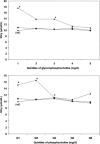The association between betaine and choline intakes and the plasma concentrations of homocysteine in women
- PMID: 17921386
- PMCID: PMC2430894
- DOI: 10.1093/ajcn/86.4.1073
The association between betaine and choline intakes and the plasma concentrations of homocysteine in women
Abstract
Background: Elevated total homocysteine (tHcy), a risk factor for many chronic diseases, can be remethylated to methionine by folate. Alternatively, tHcy can be metabolized by other 1-carbon nutrients, ie, betaine and its precursor, choline.
Objective: We aimed to assess the association between the dietary intakes of betaine and choline and the concentration of tHcy.
Design: We conducted a cross-sectional analysis in 1477 women by using linear regression models to predict mean fasting tHcy by intakes of of betaine and choline.
Results: tHcy was 8% lower in the highest quintile of total betaine + choline intake than in the lowest quintile, even after control for folate intake (P for trend = 0.07). Neither choline nor betaine intake individually was significantly associated with tHcy. Choline from 2 choline-containing compounds, glycerophosphocholine and phosphocholine, was inversely associated with tHcy. These inverse associations were more pronounced in women with folate intake < 400 mug/d than in those with intakes >or=400 microg/d (P for interaction = 0.03 for phosphocholine) and in moderate alcohol drinkers (>or=15 g/d) than in nondrinkers or light drinkers (<15 g/d) (P for interaction = 0.02 for glycerophosphocholine and 0.04 for phosphocholine). The strongest dose response was seen in women with a low-methyl diet (high alcohol and low folate intake) (P for interaction = 0.002 for glycerophosphocholine and 0.001 for phosphocholine).
Conclusions: Total choline + betaine intake was inversely associated with tHcy, as was choline from 2 water-soluble choline-containing compounds. Remethylation of tHcy may be more dependent on the betaine pathway when methyl sources are low as a result of either inadequate folate intake or heavier alcohol consumption.
Figures


Similar articles
-
Dietary choline and betaine assessed by food-frequency questionnaire in relation to plasma total homocysteine concentration in the Framingham Offspring Study.Am J Clin Nutr. 2006 Apr;83(4):905-11. doi: 10.1093/ajcn/83.4.905. Am J Clin Nutr. 2006. PMID: 16600945 Free PMC article.
-
Association between B vitamin intake and plasma homocysteine concentration in the general Dutch population aged 20-65 y.Am J Clin Nutr. 2001 Jun;73(6):1027-33. doi: 10.1093/ajcn/73.6.1027. Am J Clin Nutr. 2001. PMID: 11382655
-
Are dietary choline and betaine intakes determinants of total homocysteine concentration?Am J Clin Nutr. 2010 May;91(5):1303-10. doi: 10.3945/ajcn.2009.28456. Epub 2010 Mar 10. Am J Clin Nutr. 2010. PMID: 20219967 Free PMC article.
-
The Shuttling of Methyl Groups Between Folate and Choline Pathways.Nutrients. 2025 Jul 30;17(15):2495. doi: 10.3390/nu17152495. Nutrients. 2025. PMID: 40806080 Free PMC article. Review.
-
The metabolic burden of methyl donor deficiency with focus on the betaine homocysteine methyltransferase pathway.Nutrients. 2013 Sep 9;5(9):3481-95. doi: 10.3390/nu5093481. Nutrients. 2013. PMID: 24022817 Free PMC article. Review.
Cited by
-
Choline consumption reduces CVD risk via body composition modification.Sci Rep. 2024 Jul 12;14(1):16152. doi: 10.1038/s41598-024-66039-4. Sci Rep. 2024. PMID: 38997295 Free PMC article.
-
Choline and betaine in health and disease.J Inherit Metab Dis. 2011 Feb;34(1):3-15. doi: 10.1007/s10545-010-9088-4. Epub 2010 May 6. J Inherit Metab Dis. 2011. PMID: 20446114 Review.
-
Intake of up to 3 Eggs/Day Increases HDL Cholesterol and Plasma Choline While Plasma Trimethylamine-N-oxide is Unchanged in a Healthy Population.Lipids. 2017 Mar;52(3):255-263. doi: 10.1007/s11745-017-4230-9. Epub 2017 Jan 13. Lipids. 2017. PMID: 28091798
-
Do modern types of wheat have lower quality for human health?Nutr Bull. 2020 Dec;45(4):362-373. doi: 10.1111/nbu.12461. Epub 2020 Sep 22. Nutr Bull. 2020. PMID: 33380903 Free PMC article. Review.
-
B Vitamins and One-Carbon Metabolism: Implications in Human Health and Disease.Nutrients. 2020 Sep 19;12(9):2867. doi: 10.3390/nu12092867. Nutrients. 2020. PMID: 32961717 Free PMC article. Review.
References
-
- Clarke R, Collins R, Lewington S, et al. Homocysteine and risk of ischemic heart disease and stroke—a meta-analysis. JAMA. 2002;288:2015–22. - PubMed
-
- Wu LL, Wu JT. Hyperhomocysteinemia is a risk factor for cancer and a new potential tumor marker. Clin Chim Acta. 2002;322:21–8. - PubMed
-
- Seshadri S, Beiser A, Selhub J, et al. Plasma homocysteine as a risk factor for dementia and Alzheimer's disease. N Engl J Med. 2002;346:476–83. - PubMed
-
- van Meurs JB, Dhonukshe-Rutten RA, Pluijm SM, et al. Homocysteine levels and the risk of osteoporotic fracture. N Engl J Med. 2004;350:2033–41. - PubMed
-
- Brouwer IA, van Dusseldorp M, West CE, et al. Dietary folate from vegetables and citrus fruits decreases plasma homocysteine concentrations in humans in a dietary controlled trial. J Nutr. 1999;129:1135–9. - PubMed
Publication types
MeSH terms
Substances
Grants and funding
- P01 CA087969/CA/NCI NIH HHS/United States
- T32 HL007575/HL/NHLBI NIH HHS/United States
- CA87969/CA/NCI NIH HHS/United States
- R01 DK015289/DK/NIDDK NIH HHS/United States
- CA100971/CA/NCI NIH HHS/United States
- U54 CA100971/CA/NCI NIH HHS/United States
- R01 CA050385/CA/NCI NIH HHS/United States
- AA11181/AA/NIAAA NIH HHS/United States
- AG09525/AG/NIA NIH HHS/United States
- DK55865/DK/NIDDK NIH HHS/United States
- HL07575/HL/NHLBI NIH HHS/United States
- R01 DK055865/DK/NIDDK NIH HHS/United States
- R01 DK080010/DK/NIDDK NIH HHS/United States
- CA50385/CA/NCI NIH HHS/United States
- P01 AG009525/AG/NIA NIH HHS/United States
- R01 AA011181/AA/NIAAA NIH HHS/United States
LinkOut - more resources
Full Text Sources
Medical

